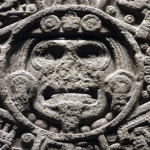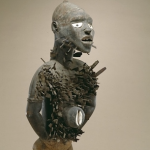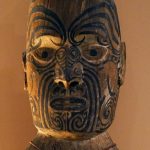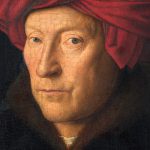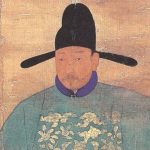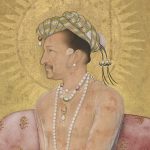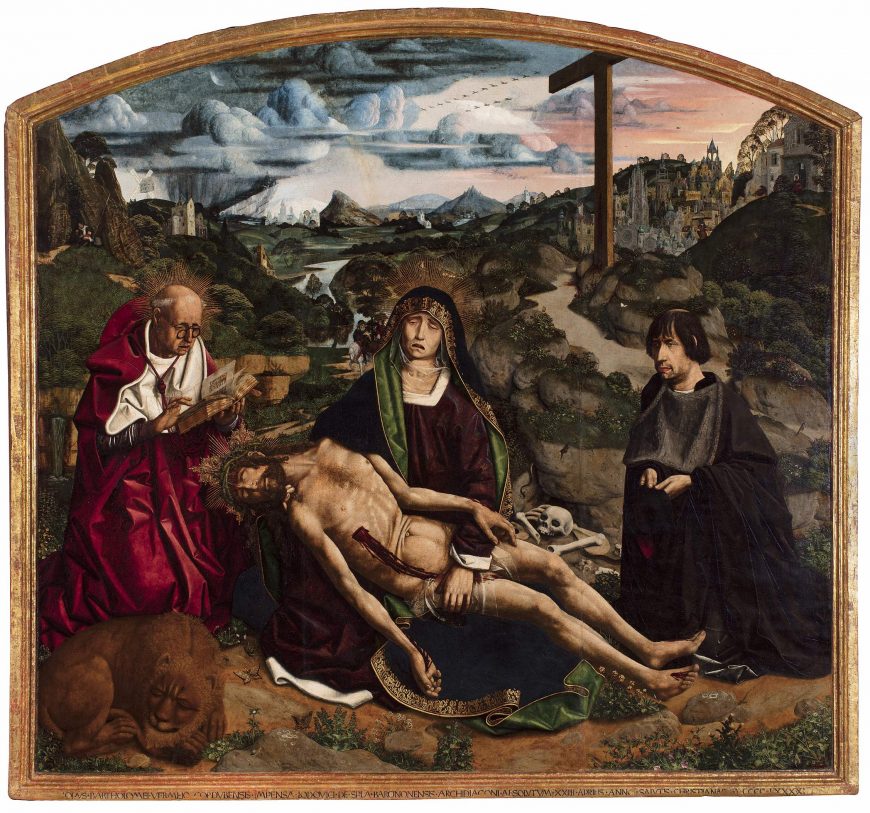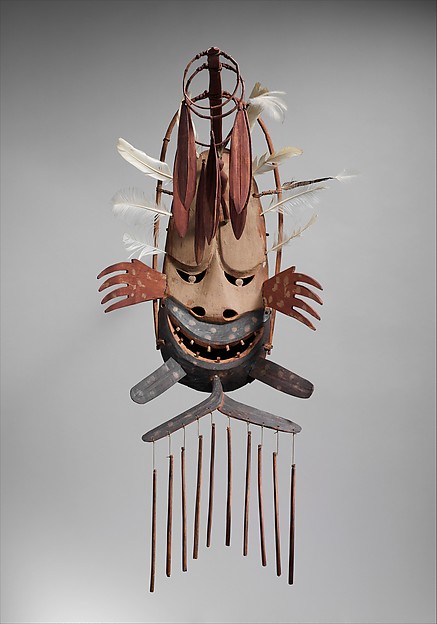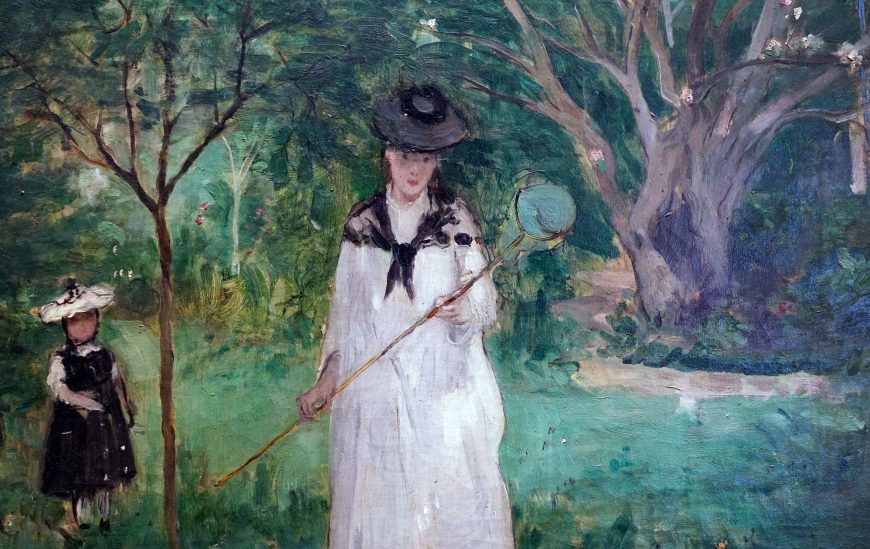Last updated April 12, 2023
This syllabus is a college-level survey course of world art and architecture from approximately the 15th century through the present.
* Syllabus generously contributed by Dr. Lauren Kilroy-Ewbank, with the following notes: This syllabus is the accumulation of 10-years of teaching different iterations of this class, and which was (in the past 7 years) run as a flipped class—students mainly watched “lecture” and completed readings outside of class so that during class time they could apply, discuss, or create materials. Mini-lectures during class filled in gaps as well. This model can be adapted for face-to-face or online course formats.
This class is designed for a 15-week semester, with each of the listed topics covering a single-class period (of roughly 75 minutes). Placeholders have been included for exams, museum visits, projects, and other opportunities, and we’ve left a few days “off” to account for holidays, etc. Each class period includes more art examples than are needed for students; still rather than remove them, they are included to give everyone the option to decide which themes or specific examples best suit their students’ needs. The works chosen for each topic are by no means comprehensive, but have been chosen for some of the important stories they can tell.
With each topic you will find a list of possible Reframing Art History textbook (ed. Lauren Kilroy-Ewbank, Smarthistory.org, 2022–now) chapters to assign, as well as individual videos and essays (many of which are also linked within each Reframing chapter), as well as important terms to know and use. For some topics you will also see additional essays or videos to provide more background information.
1. Course introduction: what is art history and what is world art history
This topic introduces the students to the basics of art history as a discipline, including how to do a visual analysis. It also introduces them to the concept of world art history (as an approach).
Reframing Art History chapters
You could ask students to read two Reframing Art History chapters (which link to the individual essays and videos below)
Introduction: Learning to look and think critically
Introduction: Close looking and approaches to art
Or, if you prefer to assign just links, you can consider the below.
The basics
What is art history and where is it going?
Art history and world art history
Introduction to art historical analysis
How to do visual (formal) analysis
An introduction to iconographic analysis
Cultural heritage in focus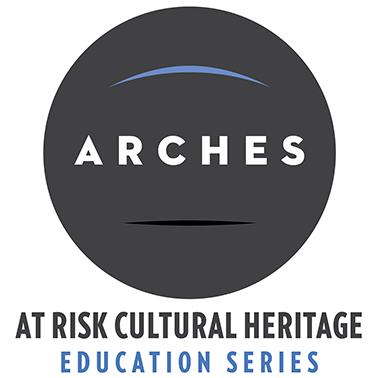 |
Background
The five major world religions
| Terms to know and use
art, visual (formal) analysis, contextual analysis, style/representational mode, iconography, function, medium, cultural heritage |
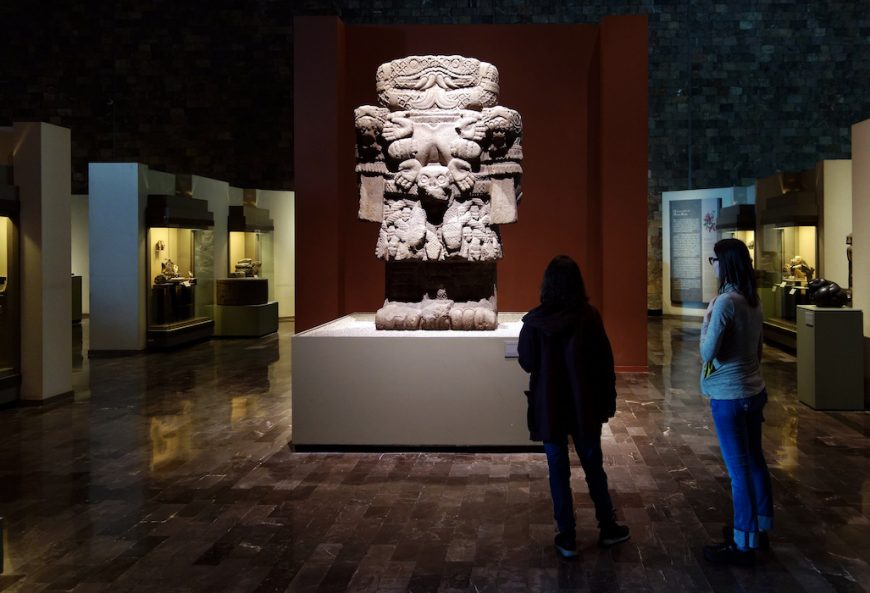
Coatlicue, c. 1500, Mexica (Aztec), found on the SE edge of the Plaza Mayor/Zócalo in Mexico City, basalt, 257 cm high (National Museum of Anthropology, Mexico City)
UNIT 1. Empire building and image-making, c. 1375–1700 |
2. The Mexica and the makings of empire, c. 1325–1550
The Mexica (also known as the Aztecs) were a powerful Mesoamerican people who built a vast empire in what is today Mexico.
Reframing Art History chapter
Mesoamerica and the Caribbean, 900–16th century
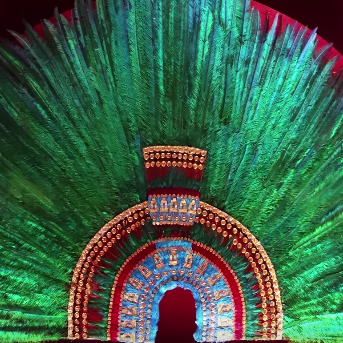
Feathered headdress, Aztec, reproduction (National Anthropology Museum, Mexico City). Original: feathers, wood, fibers, amate paper, cotton, gold, and gilded brass (World Museum, Vienna)
The basics
Introduction to the Aztecs (Mexica)
Examples
Templo Mayor and the Coyolxauhqui Stone, and an Olmec mask
The Sun Stone (or Calendar Stone)
Cultural heritage in focus |
Unearthing the Aztec past, the destruction of the Templo Mayor |
| Terms to know and use
Mesoamerica, Tenochtitlan, Triple Alliance, axis mundi, codex, spolia, low relief, Maya blue, glyph, important names: Tlaloc, Huitzilopochtli, Coyolxauhqui, Coatlicue, Centzonhuitznahua |
3. The Inka and their imperial reach, c. 1438–1532
The Inka developed a complex culture deeply rooted in the traditions that came before them. Their textiles, ceramics, metal- and woodwork, and architecture all reflect the materials, environment, and cultural traditions of the Andes, as well as the power and ambitions of the Inka empire.
Reframing Art History chapter
Late South America (c. 800 C.E.–16th century C.E.)
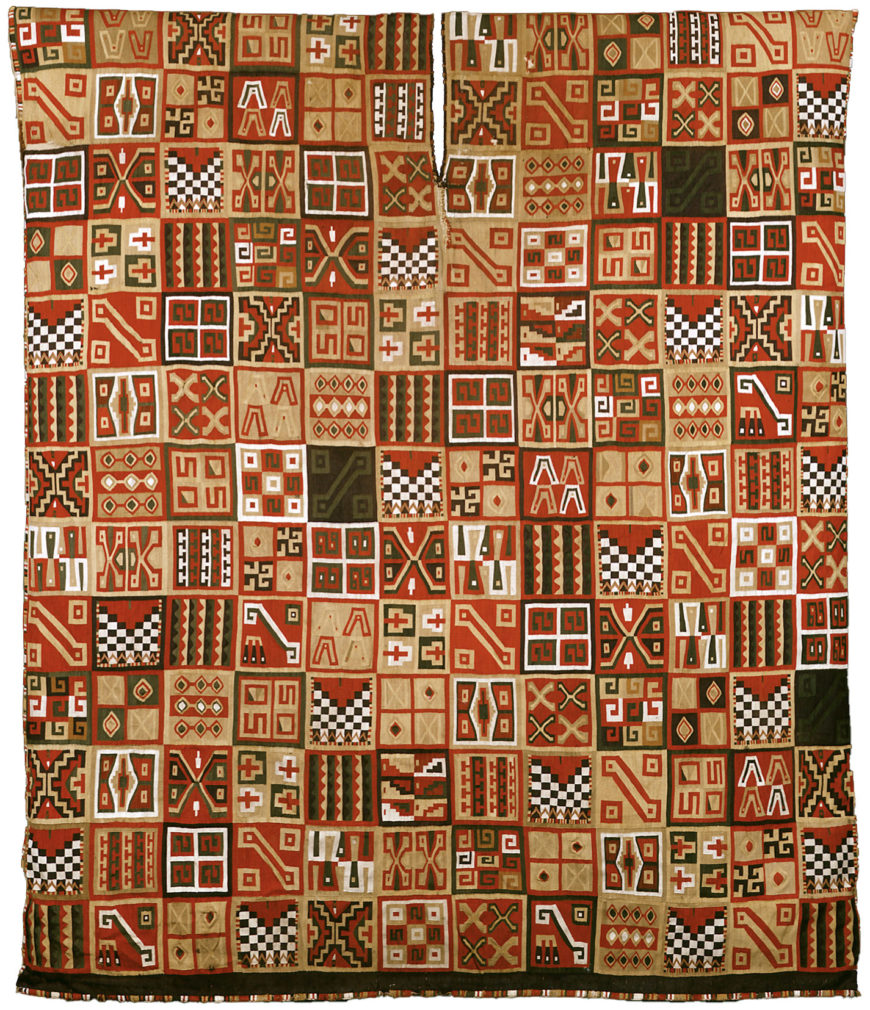
All-T’oqapu Tunic, Inka, 1450–1540, camelid fiber and cotton, 90.2 x 77.15 cm (Dumbarton Oaks, Washington D.C.)
The basics
Introduction to Andean Cultures
Examples
| Terms to know and use
Tawantinsuyu, polygonal masonry, ashlar masonry, hanan, hurin, axis mundi, ceque, khipu/quipu, unku, t’oqapu/tocapu, keru/quero, paccha, important names: Inti, Inka/Inca, Sapa Inka, Manco Capac, Mama Ocllo |
4. The renaissances of 15th-century Europe
What if instead of thinking about The Renaissance, instead we considered that there were different types of renaissances? This section (and several others that follow) begins to highlight issues of global trade, cultural entanglements, itinerancy, and gender dynamics.
Reframing Art History chapters
Portuguese contacts and exchanges, c. 1400–1800
Late medieval multimedia and devotion
Art in the Italian Renaissance Republics, c. 1400–1600
Art in Sovereign States of the Italian Renaissance, c. 1400–1600
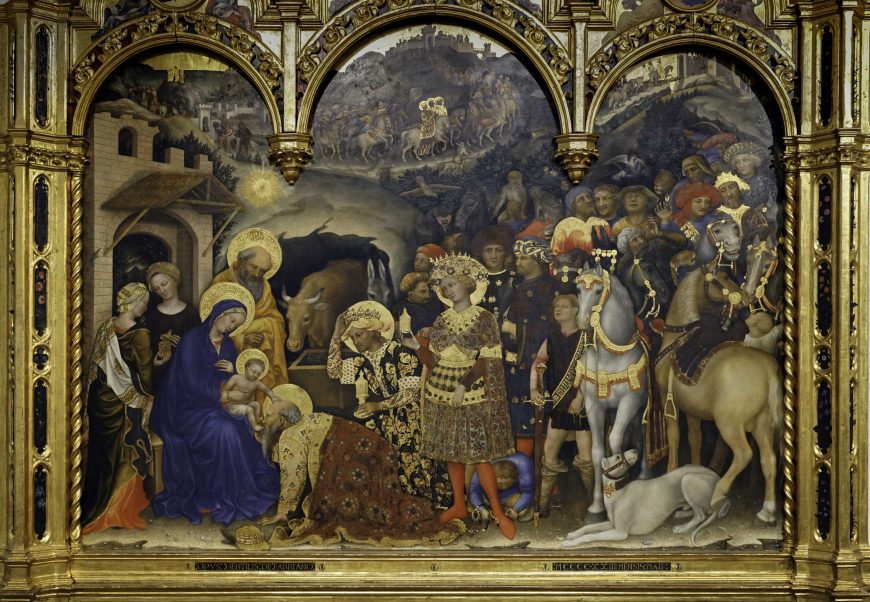
Gentile da Fabriano, Adoration of the Magi, 1423, tempera on panel, 283 x 300 cm (Uffizi Gallery, Florence), photo: Steven Zucker, CC BY-NC-SA 4.0
The basics
Expanding the Renaissance: a new Smarthistory initiative
Why commission an artwork during the renaissance?
An introduction to the Northern Renaissance in the fifteenth century
Introduction to Fifteenth-century Flanders
How to recognize Italian Renaissance art
Fifteenth-century Spanish painting, an introduction
Examples
Portraiture
Portraits of Christine de Pizan in The Queen’s Manuscript
Jan van Eyck, The Arnolfini Portrait
Gentile Bellini, Portrait of Mehmed II
Bartolomé Bermejo, Piedad with Canon Lluís Desplà
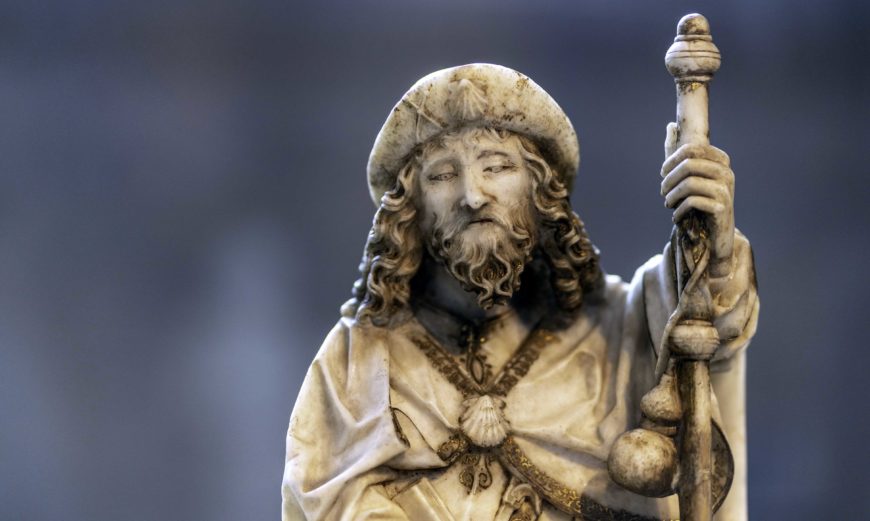
Gil de Siloé (Burgos, Castile-León, Spain), Saint James the Greater, c. 1489–93, alabaster with traces of paint and gilding, 45.9 x 17.4 x 12.5 cm (The Cloisters, The Metropolitan Museum of Art)
Humanizing the divine
Brunelleschi’s and Ghiberti’s Sacrifice of Isaac
Orsanmichele and Donatello’s Saint Mark, Florence
Giovanni Bellini, San Giobbe altarpiece
Workshop of Robert Campin, Annunciation Triptych (Merode Altarpiece)
Altarpieces and their functions
The Medieval and Renaissance altarpiece
Michael Pacher, Saint Wolfgang Altarpiece
Emotions and gender in the renaissance
Rogier van der Weyden, Deposition
Experiments in linear perspective
Alberti’s revolution in painting
Relationships between North and South
Hugo van der Goes, Portinari altarpiece
Saint James the Greater from the Tomb of Juan II of Castile and Isabel of Portugal
Global connections
Gentile da Fabriano, Adoration of the Magi (reframed)
Background
Types of renaissance patronage
Introduction to gender in renaissance Italy
Art terms explained
Chiaroscuro explained
Foreshortening explained
Linear perspective explained
Atmospheric perspective explained
| Terms to know and use
“global renaissance”, pseudo-Arabic, exoticism, pastiglia, fresco, tempera, chiaroscuro, contrapposto, vanishing point, linear perspective, aerial/atmospheric perspective, continuous narrative, historia, humanism, Northern Renaissance art, disguised symbolism, oil painting, material splendor, donor portrait, patron, empirical perspective, illuminated manuscript, lusterware, “Hispano-Flemish”, glazing, diptych, triptych, polyptych, grisaille, studiolo, maiolica |
5. The legacy of Europe in the 16th century
This section considers further the idea of “renaissances,” beginning to look at issues of global trade, cultural entanglements, colonization, itinerancy, empire, and gender and racial dynamics. Later sections of the class explore these ideas in more detail.
Reframing Art History chapter
See the ones above as well.
Printing and painting in Northern Renaissance art
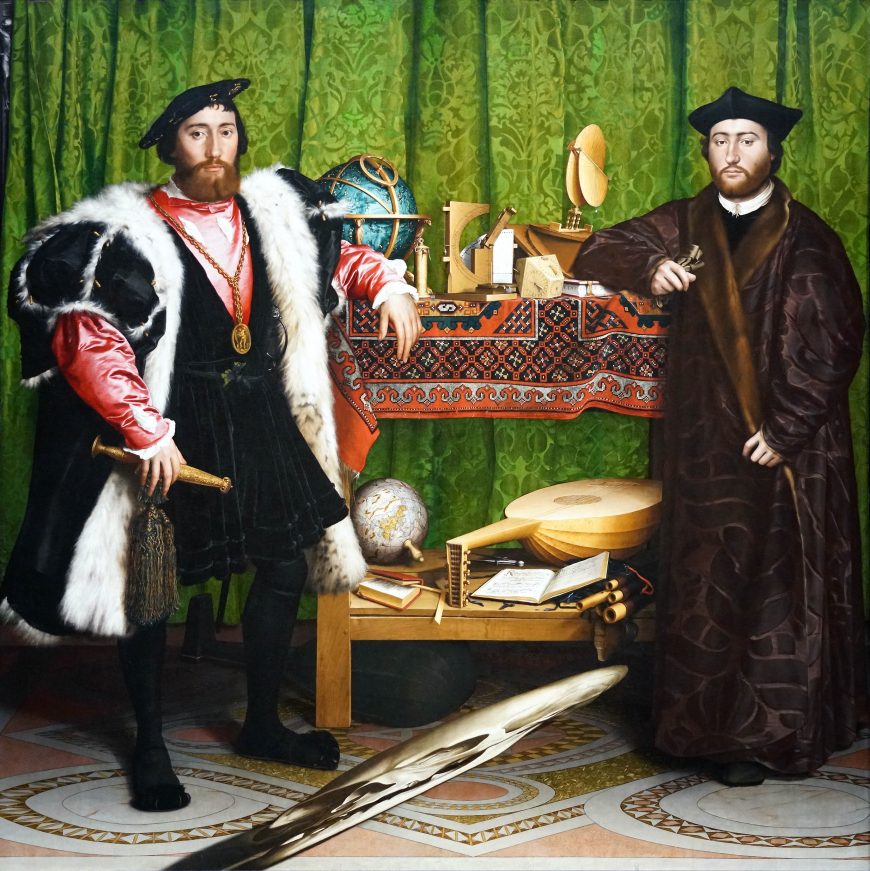
Hans Holbein the Younger, The Ambassadors, 1533, oil on oak, 207 x 209.5 cm (The National Gallery, London, photo: Steven Zucker, CC BY-NC-SA 4.0)
The basics
Alejo Fernández, The Virgin of the Navigators
Tiny timeline: Michelangelo in context
Toward the High Renaissance, an introduction
An Introduction to the Northern Renaissance in the sixteenth century
Printmaking in Europe, c. 1400–1800
Images of African Kingship, Real and Imagined
Examples
The renaissance nude
Sex, power, and violence in the renaissance nude
Confronting power and violence in the renaissance nude
Portraits and power
Albrecht Dürer, Self-Portrait (1500)
Portraits of Elizabeth I: Fashioning the Virgin Queen
Raphael, Portrait of Julius II
Women artists and patrons of the renaissance
Female artists in the renaissance
Renaissance woman: Isabella d’Este and Nicola da Urbino, a dinner service for Isabella d’Este
Sofonisba Anguissola, Self-Portraits
Scientific interests
Follower of Bernard Palissy, a rustic platter
Global connections and transculturalism
A mudéjar-style ceiling from Spain
Prints and their power
Dürer’s woodcuts and engravings
Dürer’s Rhinoceros (BBC’s History of the World in 100 Objects)
Lucas Cranach the Elder, Law and Gospel (Law and Grace)
Inventing “America” for Europe: Theodore de Bry
Johannes Stradanus and Theodoor Galle, “The Discovery of America”
Itinerant artists and objects
The Gallery of Francis I at Fontainebleau
Alonso Berruguete, Apostle or Saint (includes learning resources)
A boxwood miniature with feathers
Ambition and power
Lucas Cranach the Elder and workshop, Saint Maurice
Calls for the Reform of Art
El Greco, Burial of the Count Orgaz
| The Renaissance synagogues of Venice |
Background
Art terms explained
| Terms to know and use
colorito, disegno, reclining nude, High Renaissance, mannerism, colonialism, transatlantic slave trade, Protestant Reformation, iconoclasm, itinerancy, woodcut, engraving, etching, emblems, bas relief, portrait, self-portrait, polychromed wooden sculpture, mudéjar, Council of Trent, post-tridentine or Counter Reformation |
6. Renaissances of the Islamic world: the art of the Safavids and the Ottomans in the 16th and 17th centuries
By the fourteenth century, Islam had spread as far East as India and Islamic rulers had solidified their power by establishing prosperous cities and a robust trade in decorative arts along the all-important Silk Road. This is a complex period with competing and overlapping cultures and empires.
Reframing Art History chapter
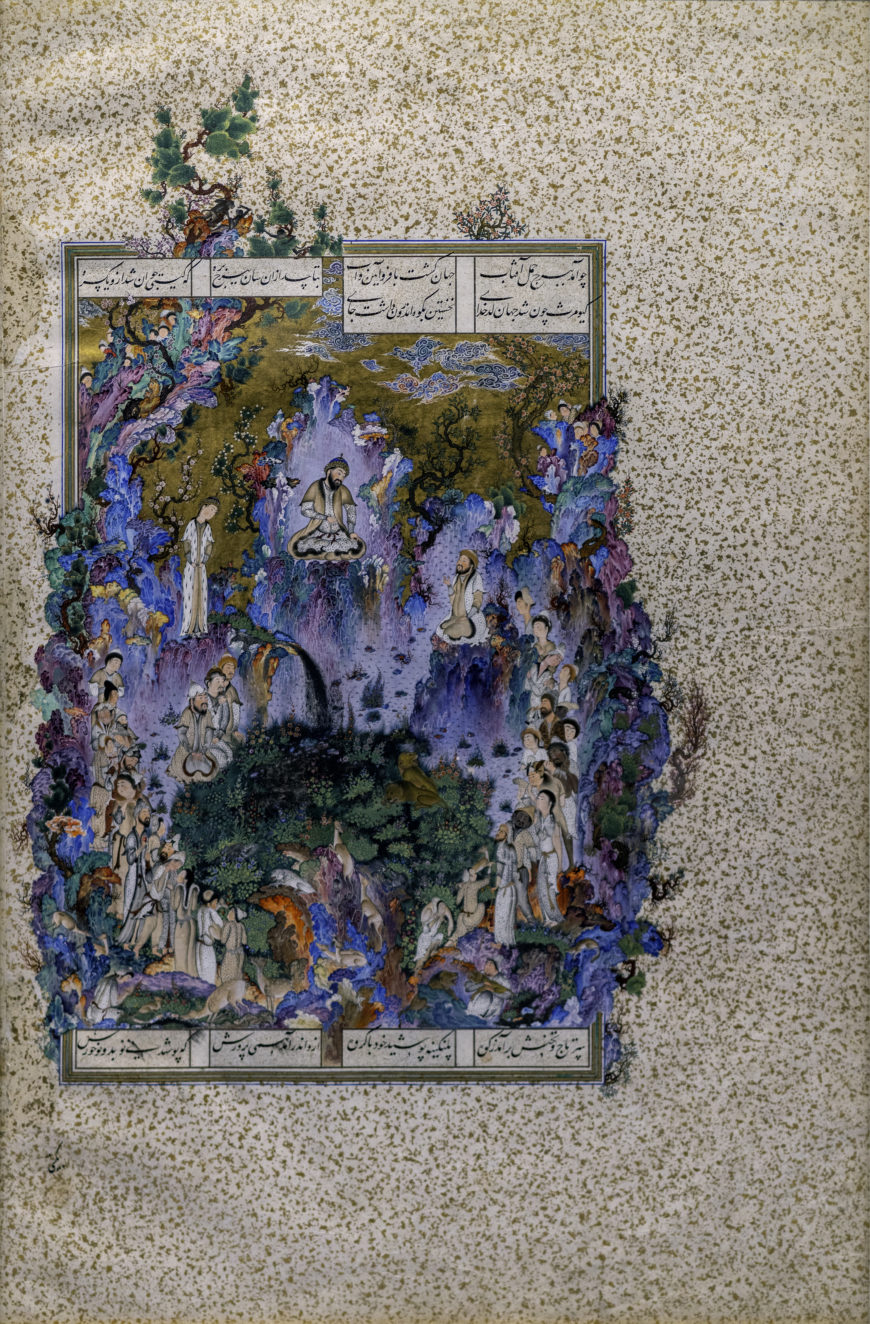
Sultan Muhammad, “The Lord of the World” shown as part of “The Court of Gayumars,” 47 x 32 cm, opaque watercolor, ink, gold, silver on paper, folio 20v, Shahnameh of Shah Tahmasp I (Safavid), Tabriz, Iran (Aga Khan Museum, Toronto; photo: Steven Zucker, CC BY-NC-SA 2.0)
The basics
Arts of the Islamic world: the later period
The Art of the Ottomans before 1600 (on the Heilbrunn Timeline)
Introduction to the court carpets of the Ottoman, Safavid, and Mughal empires
Examples
Ottoman
Mimar Sinan, Süleymaniye Mosque, Istanbul
Prayer-carpet with triple arch design
Safavid
Wine bearers in landscape, a textile
|
Cultural heritage in focus |
Bayt Farhi, a Jewish house in Damascus |
| Terms to know and use
Islam, Sufi, Shi’a, muraqqaa, Shahnameh, haft-rangi, aineh-kari, saz style, floral style, prayer rug, mosque, muqarnas, mihrab, qibla, minaret, diwan |
7. The Mughal Empire and the Nayak dynasty in the 16th and 17th century
The Mughals were responsible for some of the greatest works of art produced in the canons of both Indian and Islamic art. In southern Indian, the Nayak dynasty developed innovations in Hindu temple architecture, showcasing the diversity of cultural traditions in South Asia at this time.
The basics
A brief history of the cultures of Asia
Hinduism and Buddhism, an introduction
The Art of the Mughals before 1600 (from The Metropolitan Museum of Art’s Heilbrunn Timeline of Art History)
Examples
Vijayanagara Empire and Nayak dynasty
Hindu temples (from the Asian Art Museum)
Art and architecture of the Vijayanagara Empire
Mughals
Illustration form the Akbarnama
Bichitr, Jahangir Preferring a Sufi Shaikh to Kings
| Terms to know and use
Hinduism, bhakti, darshan, linga, Dravidian architecture, gopura, mandapa, garbagriha, iwan, chatri, jali, pietra dura, important names: Shiva, Vishnu, Meenakshi |
8. Joseon Dynasty (Korea), the Ming Dynasty (China), and the Muromachi period (Japan), 15th–17th century
Consider both the local traditions in Korea, China, and Japan, as well as the transcultural connections we find in art. This section also considers objects made for export to other parts of the globe, including porcelain and tapestries.
Reframing Art History chapters
The four seasons in the arts of Japan
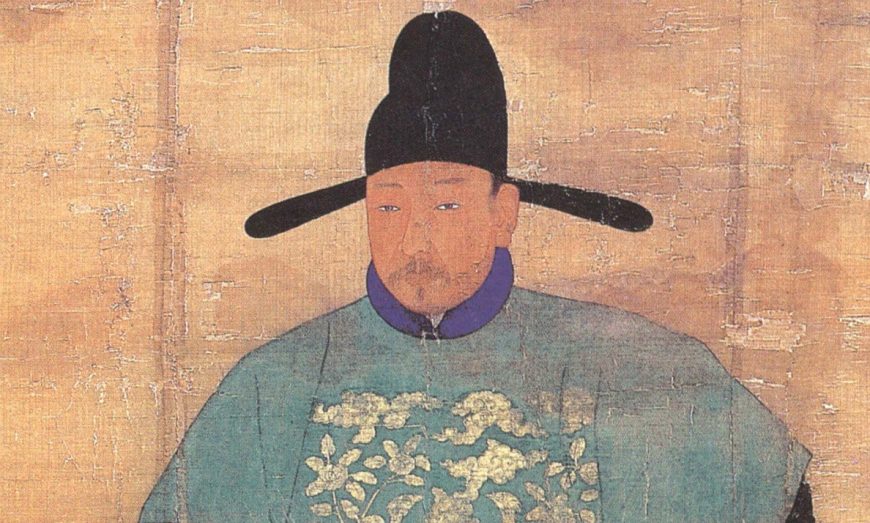
Portrait of Sin Sukju, second half of the 15th century, hanging scroll, ink and color on silk, 167 x 109.5 cm, Goryeong Sin Family Collection, Cheongwon, Treasure no. 613.
The basics
Art of the Korean Renaissance, 1400–1600 (on the Heilbrunn Timeline)
Introduction to the Muromachi period
Introduction to the Azuchi-Momoyama period
Shōguns and art (on the Heilbrunn Timeline)
Zen Buddhism (on the Heilbrunn Timeline)
Zen Buddhism (Asian Art Museum)
Examples
Joseon Dynasty
Buncheong ware with cloud and dragon design
Ming Dynasty
Tomb of the first Ming emperor
Ming dynasty ceramics
Chinese porcelain: production and export
A Ming chicken cup (object entry on The Metropolitan Museum of Art website)
Painting, poetry, and landscape during the Ming dynasty
Wang Lü, Landscapes of Mount Hua (Huashan)
Master of the (Fishing) Nets Garden
The world connected: A tapestry made in China at a Jesuit school for export to Portugal
The Abduction of Helen tapestry
Muromachi Period
Bamboo in the Four Seasons: painting and poetry in Japan
Zen Buddhist art in Japan
Ryōanji (Peaceful Dragon Temple)
Kichizan Minchō, Monju Bosatsu
Christians in Japan and the legacy of the Jesuits
A portrait of St. Francis Xavier and Christianity in Japan
Background
A brief history of the cultures of Asia
Chinese calligraphy, an introduction
| Terms to know and use
Joseon dynasty, Ming dynasty, Muromachi period, Neo-Confucianism, porcelain, buncheong ware, Daoism, hanging scroll, kaolin, cobalt, doucai, underglaze, blue-and-white porcelain, tapestry, Jesuits, transculturalism, Zen Buddhism, haboku, kare sansui, chanoyu, raku ware, wabi-sabi, shōgun, samurai, Kano school, byobu, kiga, gold leaf |
9. Europe invades the Americas
This section focuses on the effects of the Spanish, Portuguese, and English invasions of the Americas. This is also the time when the transatlantic slave trade originated. It is important that we address how colonized and enslaved peoples borrowed, adapted, and rejected European forms, subject matter, and ideas (often forced on them), and what these choices might mean.
Reframing Art History chapter
The art of the viceroyalty of New Spain
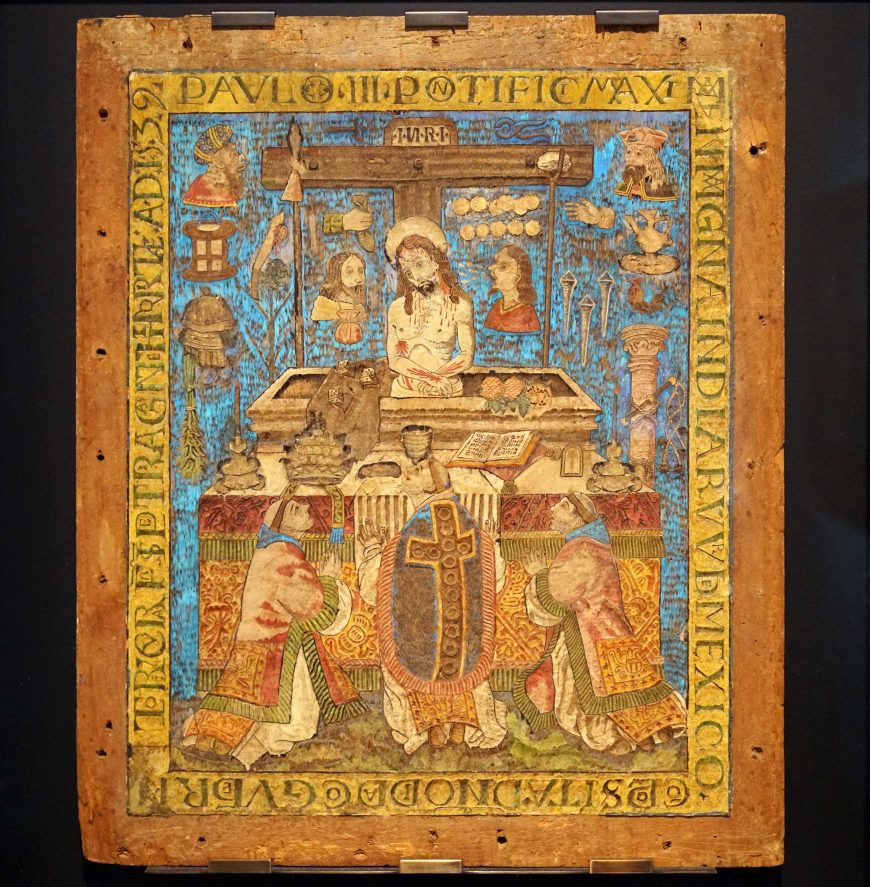
The Mass of St. Gregory, 1539, feathers on wood with touches of paint, 26 1/4 x 22 inches / 68 x 56 cm (Musee des Jacobins)
The basics
Introduction to the Spanish Viceroyalties in the Americas
Hispaniola’s early colonial art, an introduction
Examples
The Viceroyalty of New Spain
Mission churches and art their art in New Spain
Mission churches as theaters of conversion in New Spain
Murals from San Agustín de Acolman and its atrial cross
Mission Church, San Esteban del Rey, Acoma Pueblo
Featherworks: The Mass of St. Gregory
Classicizing forms and tropes in New Spain
Classical architecture in Viceregal Mexico
Diego de Valadés, engravings in Rhetorica Christiana
Mesoamerican manuscripts made under the new colonial order
Frontispiece of the Codex Mendoza
Collecting objects from the Americas
The Medici collect the Americas
New saints
The Viceroyalty of Peru
An introduction to the Viceroyalty of Peru
An introduction to religious art and architecture in early colonial Peru
Early viceregal art and architecture in Colombia
The importance of textiles
Textiles in the colonial Andes
Speaking out against abuses and chronicling history
Guaman Poma and The First New Chronicle and Good Government
“Bad Confession” in Guaman Poma’s The First New Chronicle and Good Government
European artists travel to the Americas
Bernardo Bitti, Coronation of the Virgin
Colonial Brazil
An introduction to colonial Brazil
English colonies
James Wooldridge, Indians of Virginia
| Terms to know and use
viceroyalty, convento, friar, atrium, cloister, pueblo, adobe, amanteca, hybrid, featherwork, tlacuilo, Wunderkammern |
10. Empires and transculturalism in western and eastern Africa, 15th–17th century
In the 15th century, powerful empires produced art in brass, wood, ivory, and more. There was also sustained engagement between Europe and Africa. The Portuguese, and later the Dutch and English, began trade with cities along the western coast of Africa around 1450. Trade and connections were not only with Europe, but also with Asia.
The basics
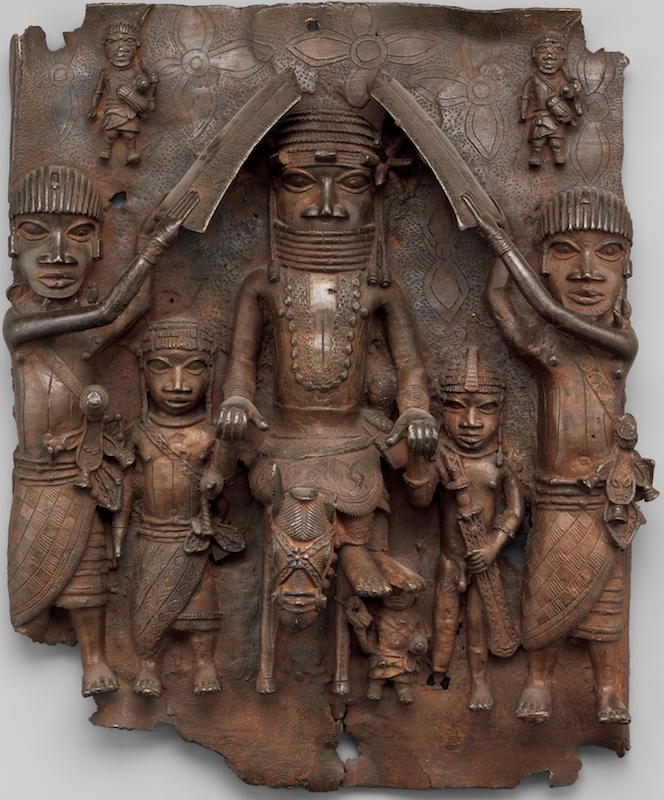
Plaque: Equestrian Oba and Attendants, 1550–1680, Nigeria, Court of Benin, Edo peoples, brass, 49.5 x 41.9 x 11.4 cm (The Metropolitan Museum of Art)
Historical overview: from the 1600s to the present
African art and the effects of European contact and colonization
Benin art: patrons, artists, and current controversies
Examples
Edo Kingdom of Benin
Benin Plaque: Equestrian Oba and Attendants
Sapi
Kingdom of the Kongo
Kongo Triple Crucifix (on MAVCOR)
Ethiopia
Tanzania
| Repatriating artworks
Seizure of Looted Antiquities Illuminates What Museums Want Hidden |
| Terms to know and use
plaque, lost-wax technique, British Punitive Expedition of 1897, oba, iyoba, Sapi, saltcellar, Solomonic period, Gospel book, psalter, icon |
11. Global Baroque and Rococo, and the politics of globalizations in the 17th and 18th century
Learn about the how what we call Baroque and Rococo art were global phenomena that stretched across the globe.
Reframing Art History chapters
Secular matters of the global baroque
The sacred baroque in the Catholic world
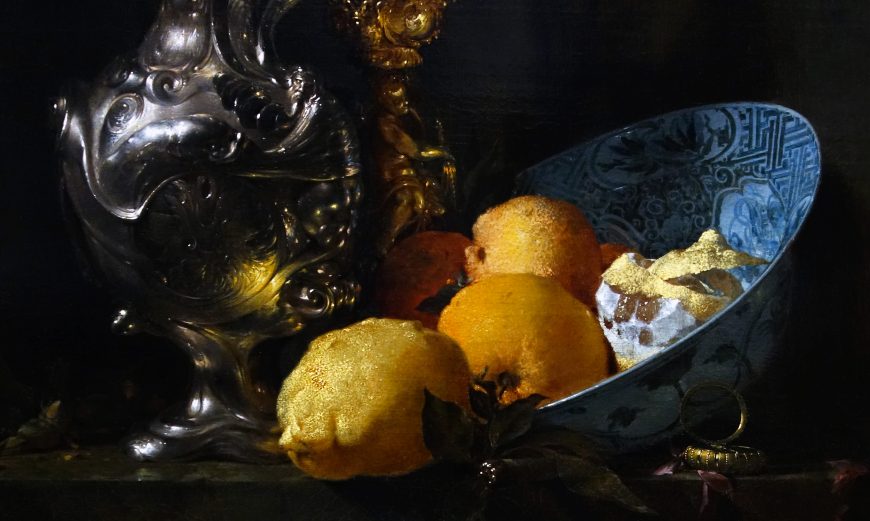
Willem Kalf, Still Life with a Silver Ewer and a Porcelain Bowl, 1660, oil on canvas, 73.8 x 65.2 cm (Rijksmuseum)
The basics
A beginner’s guide to Rococo art
Examples
Spain and its viceroyalties
Velázquez, The Waterseller of Seville
Juan Martínez Montañés and Francisco Pacheco, Christ of Clemency
A Still Life of Global Dimensions: Antonio de Pereda’s Still Life with Ebony Chest
Screen with the Siege of Belgrade and Hunting Scene (or Brooklyn Biombo)
Jerónimo de Balbás, Altar of the Kings (Altar de los Reyes)
Diego Quispe Tito, Last Judgment, 1675
Cusco School Artist, Saint Joseph and the Christ Child
Northern Europe and its reach globally
Peter Paul Rubens, Arrival (or Disembarkation) of Marie de Medici at Marseilles
Willem Kalf, Still Life with a Silver Ewer
Albert Eckhout, series of eight figures
Louis le Vau, André le Nôtre, and Charles le Brun, Château de Versailles
Jean-Honoré Fragonard, The Swing
Architecture in 18th-century Germany
Brazil
Church of São Francisco de Assis, Ouro Preto, Brazil
Sanctuary of Bom Jesus de Matosinhos of Congonhas do Campo, 1757-1872
Mestre Valentim, Passeio Publico, Rio de Janeiro
Italy
Caravaggio, Calling of St. Matthew
Artemisia Gentileschi, Judith Slaying Holofernes
Gian Lorenzo Bernini, Baldacchino, Saint Peter’s
More on the reach of the Baroque and Rococo
The European Palaces of the Qianlong Emperor, Beijing
The Gwoździec Synagogue in Ukraine
| Terms to know and use
baroque realism, tenebrism, dynamic baroque, bodegón, still-life, biombo, enconchado, mysticism, Ultrabaroque, estípite, Cusco School, absolute monarch (Louis XIV), French garden style, Rococo, salon, stuccowork, rocaille, chinoiserie |
12–13. Placeholders for an exam and museum trip
Do other things in the class.
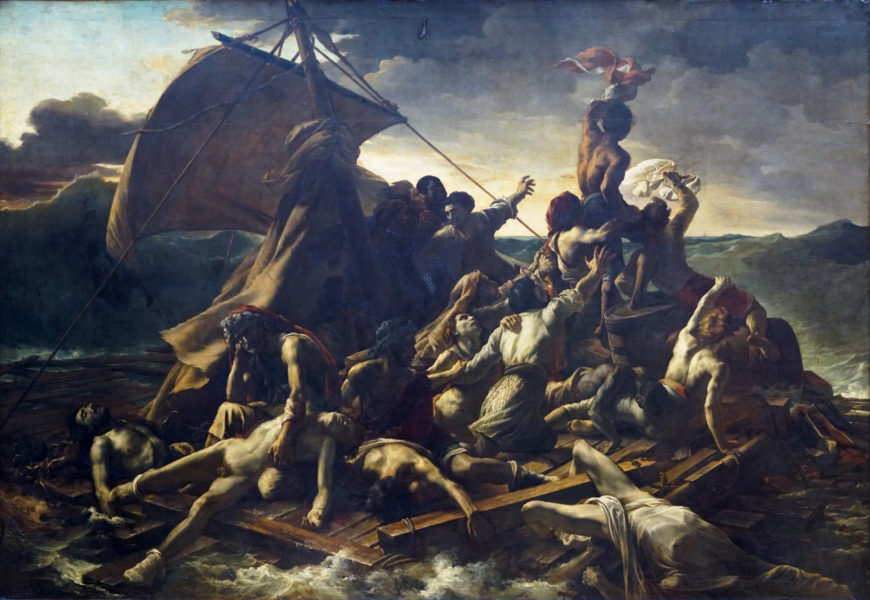
Théodore Géricault, Raft of the Medusa, 1818–19, oil on canvas, 4.91 x 7.16m (Musée du Louvre, Paris)
UNIT 2: Experimentation, exploitation, and the negotiation of traditions, c. 1700–1900 |
14. The Enlightenment, Neoclassicism, and Romanticism in Europe and the Americas
New ways of thinking, scientific advancements, the birth of the museum, and art academies—all framed against slavery, global trade, exploration and expansion, colonialism, and more.
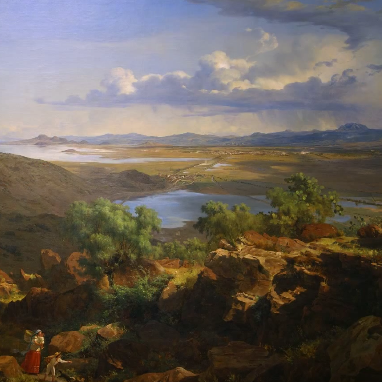
José María Velasco, The Valley of Mexico from the Santa Isabel Mountain Range (Valle de México desde el cerro de Santa Isabel), 1875, oil on canvas, 137.5 x 226 cm (Museo Nacional de Arte, INBA, Mexico City)
Reframing Art History chapters
Art in American Colonies and the United States, c. 1600–1860
Empires and their endings in the late 18th and 19th centuries
The basics
The Age of Enlightenment, an introduction
Neoclassicism, an introduction
A beginner’s guide to Romanticism
Romanticism in France, an introduction
Covered sugar bowl, the Triangle Trade
Examples
Understanding museums
Museums and politics: The Louvre
Local art appropriation: the loot in the Louvre
Academies of art
The Formation of a French School: the Royal Academy of Painting and Sculpture
Vigée Le Brun, Self-Portrait with Her Daughter
Félix Parra, Fray Bartolomé de las Casas
Enlightenment and Neoclassical impulses
Jacques-Louis David, Oath of the Horatii
Angelica Kauffman, Cornelia Pointing to her children as Her Treasures
Marie-Guillemine Benoist, Portrait of Madeleine
Spaniard and Indian Produce a Mestizo, attributed to Juan Rodriguez Juárez
Early Scientific Exploration in Latin America
Richard Evans, Portraits of the Caribbean’s first Black king and prince
Romanticism and orientalism
Baron Antoine-Jean Gros, Napoleon Bonaparte Visiting the Pest House in Jaffa
Théodore Géricault, Raft of the Medusa
Francisco Goya, And there’s nothing to be done from The Disasters of War
Jean-Auguste-Dominique Ingres, La Grande Odalisque and painting colonial culture
John Nash, Royal Pavilion, Brighton
Landscape painting
Frederic Edwin Church, Niagara and Heart of the Andes
Jose Maria Velasco, The Valley of Mexico from the Santa Isabel Mountain Range
The development of photography
Louis Daguerre, Paris Boulevard
Timothy O’Sullivan, Ancient Ruins in the Cañon de Chelle
| African Burial Grounds
Seneca Village: the lost history of African Americans in New York |
| Terms to know and use
Enlightenment, empiricism, Academy, Industrial Revolution, salon, museum, Neoclassicism, history painting, casta painting/pinturas de castas, French Revolution, tricoleur, Romanticism, daguerreotype, orientalism, exoticism, costumbrismo, picturesque, cartes de visite, Hudson River School |
15. West and southwestern art of what is today the U.S., 1800–early 20th century
Complicating and nuancing what we call “American art” in the 19th and early 20th century.
The basics
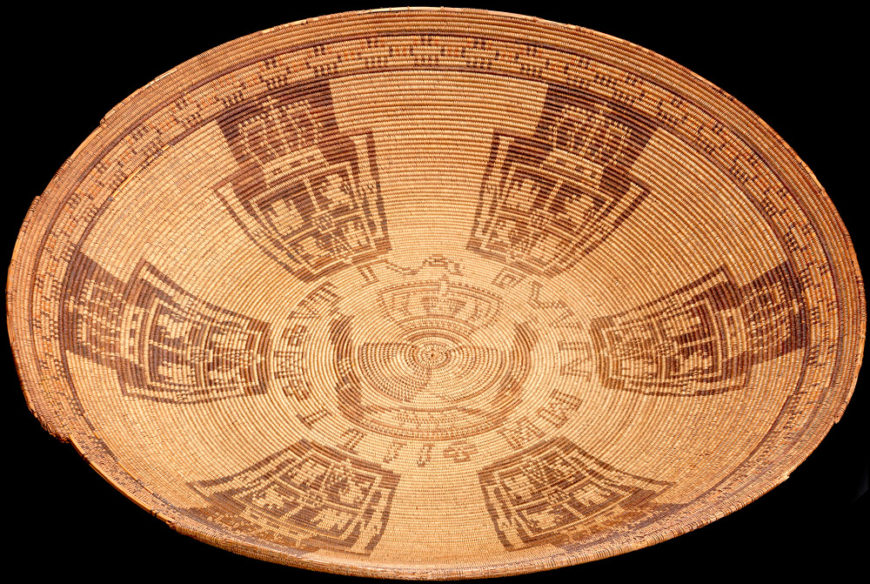
Juana Basilia Sitmelelene, coin basket, c. 1815–1822, Sumac, juncus textilis, mud dye, 9 x 48 cm (The National Museum of the American Indian)
Terms and Issues in Native American Art
About geography and chronological periods in Native American art
Introduction to Plains and Plateau tribes (from the NMAI)
Introduction to Southwestern cultures (from the NMAI)
Examples
West
Juana Basilia Sitmelelene, Presentation Basket (Chumash)
Tatonka-I-Yatanka’s (Chief Sitting Bull’s, Hunkpapa Lakota), Feathered war bonnet
Cotsiogo, Hide Painting of the Sun Dance
Tȟatȟáŋka Waŋžíla/Henry Oscar One Bull, Custer’s Last Stand, a Lakota view
War Shirt (Upper Missouri River)
Thomas Moran, Grand Canyon of the Yellowstone
Emanuel Gottlieb Leutze, Westward the Course of Empire Takes Its Way
Southwest
Pueblo architecture and its relationship to place
Nampeyo (Hopi-Tewa), polychrome jar
Maria Martinez, Black-on-black ceramic vessel
| Terms to know and use
Native American, American Indian, First Nation(s), tribe, band, quillwork, beadwork, Plains, tipi/teepee, hide painting, Battle of Greasy Grass (Little Bighorn), war shirt, war bonnet, Sun Dance, repatriation, Indigenous sovereignty, Manifest Destiny, World’s Columbian Exposition of 1893, kiva, ancestral footprints, black-on-black ceramics |
16. Northwest Coastal and Arctic/Subarctic Art
Adaptability and ingenuity characterize Native peoples of the Northwest Coast and Arctic regions in the 19th and 20th century.
Reframing Art History chapter
The basics
Introduction to Native cultures of the Northwest (on the NMAI)
Introduction to Arctic/SubArtic cultures (from the NMAI)
Examples
Northwest Coast
Haida Totem Pole, from Old Kasaan
Proud Raven Totem Pole at Saxman Totem Park
Ceremonial belt (Kwakwaka’wakw)
Yup´ik Yurapiaq and the Quyana (Thank You) Song Dance (at the NMAI)
| Terms to know and use
Northwest Coastal Style, form line, potlatch, totem pole, transformation masks, numayn, Ku.éex’ Entrance Dance, moiety, Chilkat, Yurapiaq and the Quyana (Thank You) Song Dance |
17. Paintings, Prints, and Visual Culture in East Asia
New developments in printmaking, painting, and photography helped to usher in new art forms and themes in East Asia, even as some artists continued to use more traditional methods to produce their art.
Reframing Art History chapters
The four seasons in the arts of Japan
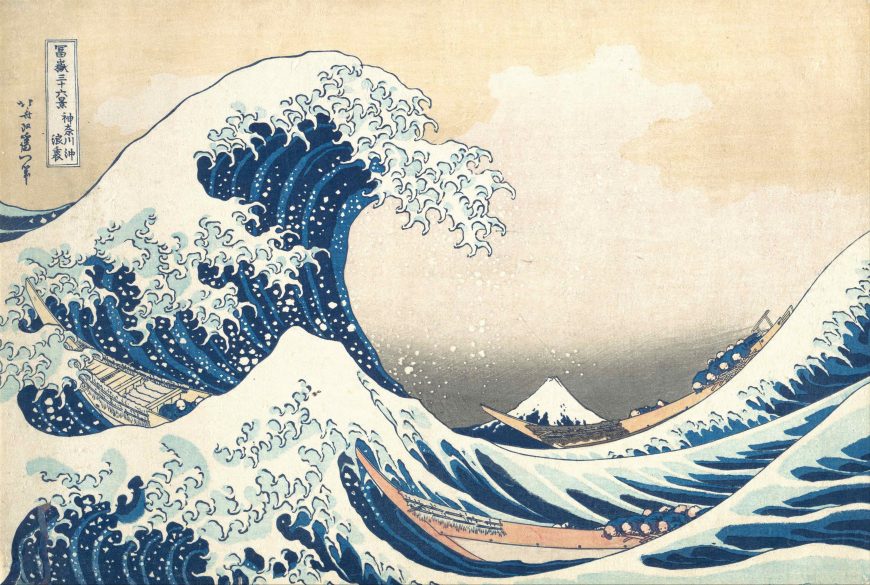
Katsushika Hokusai, Under the Wave off Kanagawa (Kanagawa oki nami ura), also known as The Great Wave, from the series Thirty-six Views of Mount Fuji (Fugaku sanjūrokkei),ca. 1830–32, polychrome woodblock print, and ink and color on paper, 25.7 x 37.9 cm (The Metropolitan Museum of Art)
The basics
Rinpa Painting Style (from the Metropolitan Museum of Art’s Heilbrunn Timeline of Art HIstory)
Examples
Japan
Ogata Kōrin, Red and White Plum Blossoms
Utagawa Kunisada I, Visiting Komachi, from the series Modern Beauties as the Seven Komachi
Hokusai, Under the Great Wave off Kanagawa (The Great Wave)
Hokusai’s printed illustrated books
China
Lang Jingshan and early Chinese photography
| Terms to know and use
Rinpa school, tarashikomi (puddled ink), mokkotsu, ukiyo-e, bijinga and geisha, kabuki, genre painting, Prussian blue, kyōka, manga, Shanghai school, composite photography |
18. Complex art, rituals, and traditions in Africa in the 19th and early 20th century
Masks, power figures, complex cloth, and golden stools—these are a few of the types of art made in the 19th century and early 20th century that had important social, political, and ritual associations in different parts of Africa.
Reframing Art History chapters
The arts of Africa, c. 18th–20th century
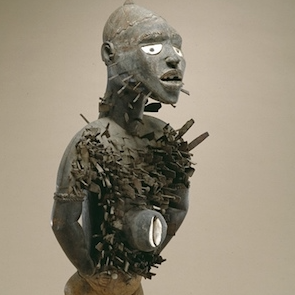
Power figure (Nkisi n’kondi), Kongo peoples (Democratic Republic of the Congo). c. late 19th century, wood and metal, 36 x 18 1/2 x 14 1/4″ / 16/8 x 47 x 36.2 cm (Detroit Institute of Arts)
The basics
Introduction to the Dogon (U. of Iowa)
Introduction to the Kongo (U. of Iowa)
Introduction to the Asante (U. of Iowa)
Introduction the Fang (U. of Iowa)
Introduction to Cameroon Grasslands (U. of Iowa)
Examples
Dogon
Asante
Golden Stool (Sika dwa kofi), Asante peoples
Kente cloth (Asante and Ewe peoples)
Cameroon Grasslands
Palm Wine Vessel (Cameroon Grasslands peoples)
Fang
Male reliquary Guardian Figure (Fang peoples)
Kongo
Amazigh (Berber)
| Terms to know and use
nommo, dama, nkisi nkondi (plural minkisi minkondi), Asante Kingdom, kente, reliquary, talisman |
19. Arts of Micronesia, Melanesia, and Polynesia in the 19th century and beyond
Peoples of the Pacific understand the ocean as a connective force, one that connects islands and peoples together.
The basics
Navigation Chart, Marshall Islands
Examples
Micronesia
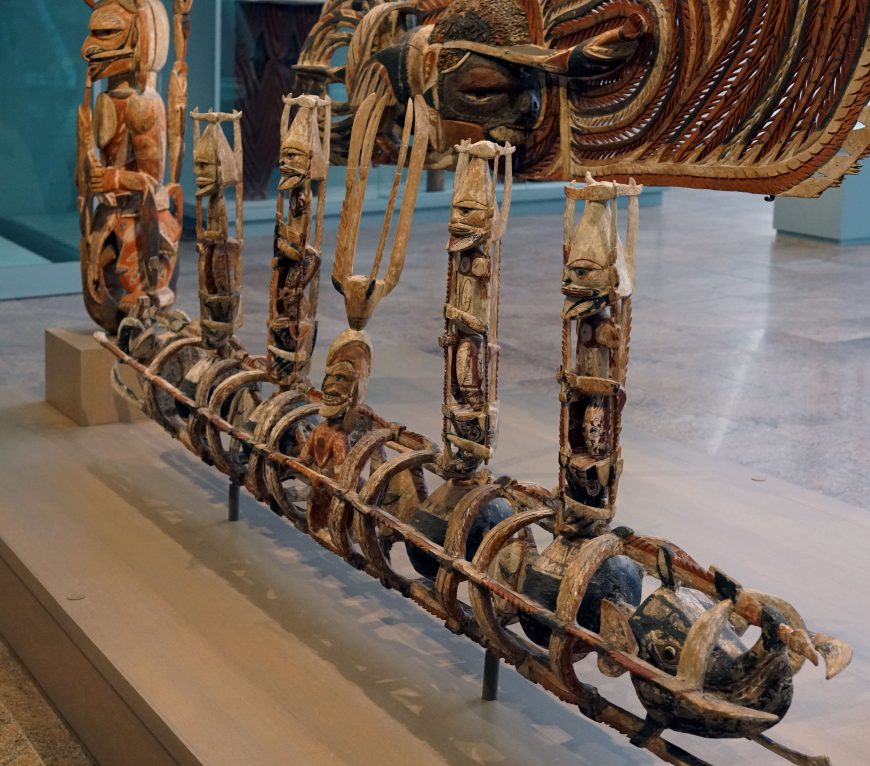
Funerary Carving (Malagan), late 19th–early 20th century, Papua New Guinea, New Ireland, New Ireland, wood, 280.7 x 87.6 x 26.7 cm (The Metropolitan Museum of Art)
Melanesia
Polynesia
History of tatau (tattoo) (PBS: Skin Stories)
Gottfriend Lindauer, Tamati Waka Nene
Helmet (mahiole) (from Annenberg Learner: Art Through Time, a Global View)
Necklace (Lei Niho Palaoa), Hawai’i
| Paikea at the American Museum of Natural History |
| Terms to know and use
Oceania, mana, tapu, tatau, tiki, moko, malagan, bis poles, marae, pare, amo, taonga tuku iho, mahiole, moana |
20. Art of Modern Life: Impressionism and Beyond
Paris became a hub for artistic developments in the mid-19th century, with artists coming from the Americas to explore new ways of seeing.
Reframing Art History chapters
Journeys in the 19th-century European world
A wider world in 19th-century Europe
Art and Nationalism in 19th-century Latin America
The basics
Becoming Modern, an introduction
Haussmann the Demolisher and the creation of modern Paris
Impressionism, an introduction
Impressionism: painting modern life
Latin American artistic pilgrimages to Paris
Introduction to Neo-Impressionism, Part I
Introduction to Neo-Impressionism, Part II
Examples
Realism
Gustave Courbet, The Stone Breakers
Impressionism
Claude Monet, Rouen Cathedral series
Francisco Oller, Hacienda La Fortuna (from the Brooklyn Museum)
Post-Impressionism
Georges Seurat, A Sunday on La Grande Jatte-1884
Vincent van Gogh, The Starry Night
Auguste Rodin, The Burghers of Calais
Hector Guimard, Cité entrance, Métropolitain, Paris
Background
What does “Impressionism” mean?
Neo-Impressionist Color Theory
| Terms to know and use
Modern art (vs. modernity, modernization, modernism), avant-garde, Realism, Charles Baudelaire, Hausmannization of Paris, bourgeois, modernism, en plein air, Japonisme, Impressionism, synthetic tube paints, Neo-impressionism, Post-impressionism, pointillism, divisionism, impasto, primitivism, art nouveau |
21–22. Placeholders for an exam and project development day
Use this days for other projects.
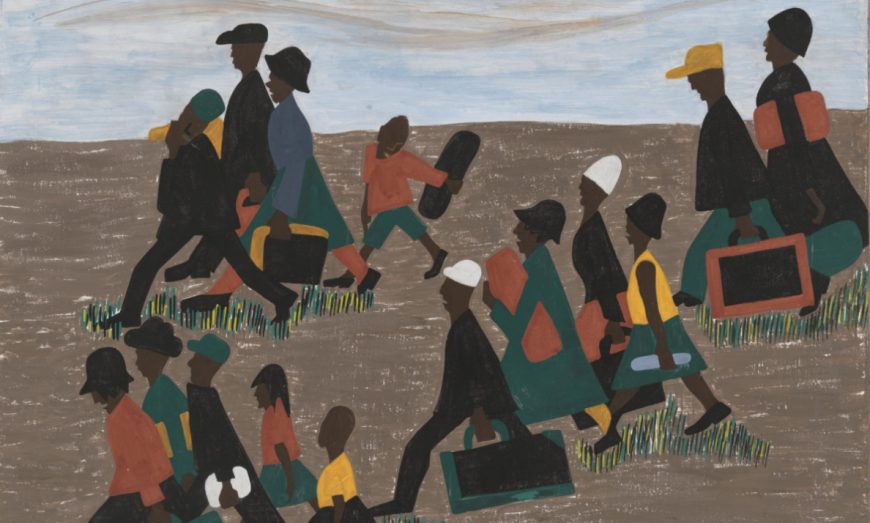
Jacob Lawrence, The Migration Series, 1940–41, 60 panels, tempera on hardboard (even numbers at The Museum of Modern Art, New York, odd numbers at the Phillips Collection, Washington D.C.)
UNIT 3. Moving toward the world of today, 1900–present |
23. Modern art
Developments in modern art in a global context.
Reframing Art History chapters
Modern Art, Colonialism, Primitivism, and Indigenism: 1830–1950
The potentials of modern Chinese art in the Republic of China (1912–49)
Itinerant Modernisms: Cosmopolitans, Exiles, Travelers since 1950
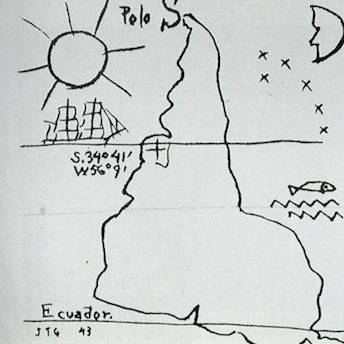
Joaquin Torres García, América Invertida (Inverted America), 1943, ink on paper, 22 x 16 cm (Fundación Torres García, Montevideo)
The basics
Picasso and the new language of Cubism
The origins of modern art in São Paulo, an introduction
Mexican Muralism: Los Tres Grandes—David Alfaro Siqueiros, Diego Rivera, and José Clemente OrozcoDiego Rivera, Detroit Industry Murals
Geometric Abstraction in South America, an introduction
Abstract Expressionism, an introduction
Introduction to photography in the early 20th century
Examples
Early explorations in abstraction before WWI
Henri Matisse, Bonheur de Vivre
Pablo Picasso, Les Demoiselles d’Avignon
Vasily Kandinsky, Improvisation 28 (second version)
Velino Shije Herrera (Ma Pe Wi), Design, Tree and Birds
Challenging conventions
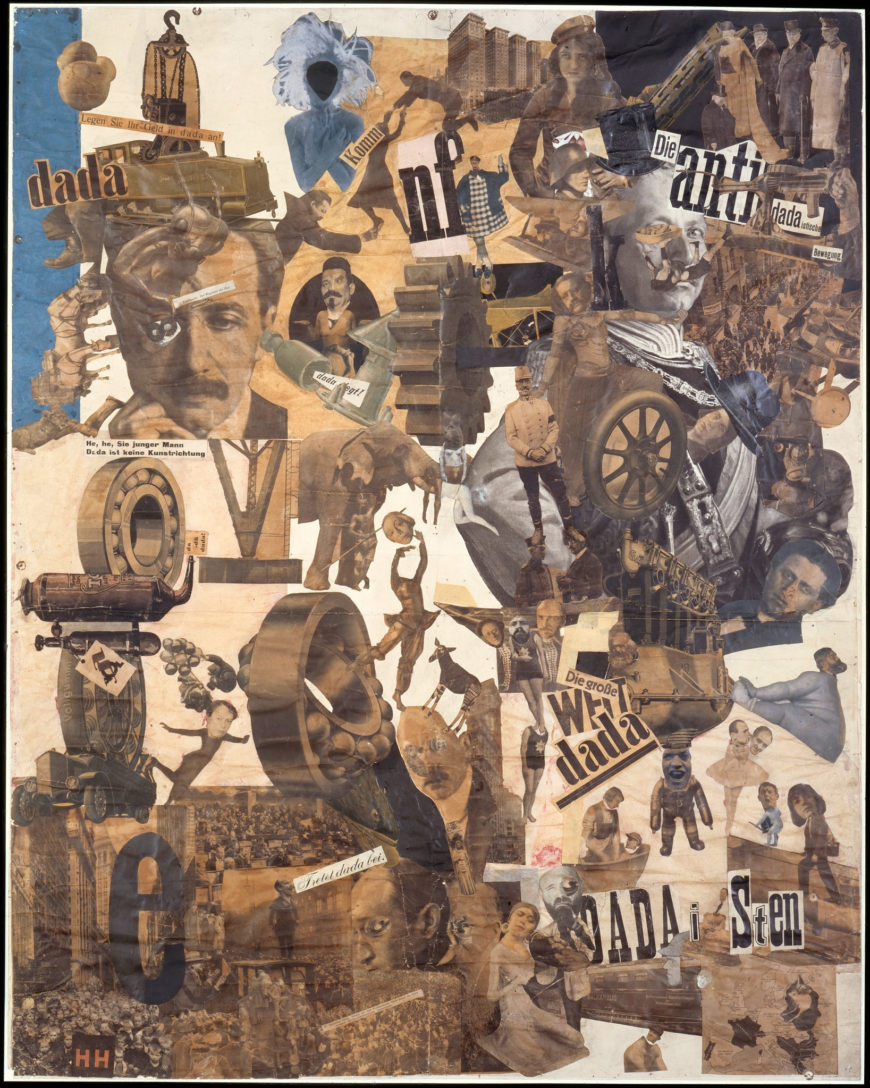
Hannah Höch, Cut with the Kitchen Knife Dada Through the Last Weimar Beer-Belly Cultural Epoch of Germany, collage, mixed media, 1919-192
Art after World War I: responses to the war and its consequences
Yasuo Kuniyoshi, Little Joe with Cow
Dreams, visions, and nightmares
Meret Oppenheim, Object (Fur-covered cup, saucer, and spoon)
Public and political
Diego Rivera, The History of Mexico
Explorations in abstraction after WWI and beyond
Joaquín Torres-García, Inverted America
Jacob Lawrence, The Migration Series
Jackson Pollock, Autumn Rhythm (Number 30)
Joan Mitchell, City Landscape, finding meaning in abstraction
The International Style in architecture
The international style in Mexico and Brazil
Ludwig Mies van der Rohe, Seagram Building, New York City
| Terms to know and use
Fauvism, French Expressionism, German Expressionism, Der Blaue Reiter (“The Blue Rider”), Kandinsky’s On the Spiritual in Art, theosophy, Cubism, Dada, Dada Manifesto, readymade, Surrealism, exquisite corpse, psychic automatism, constructive universalism, Arte Concreto Invención (Argentina), los tres grandes, School of the South, primitivism, international style, Action painting, abstract expressionism |
24. Using visual languages to critique and question, art of the 60s and 70s
The 60s and 70s witnessed some of the biggest transformations in art.
Reframing Art History chapters
African American art and social justice
Art into Life: Anti-Modernist Gestures
Re-Mapping Land Art: Earthworks, Borderlands, Ecology
Popular, Transient, Expendable: Print Culture and Propaganda in the 20th century
The basics
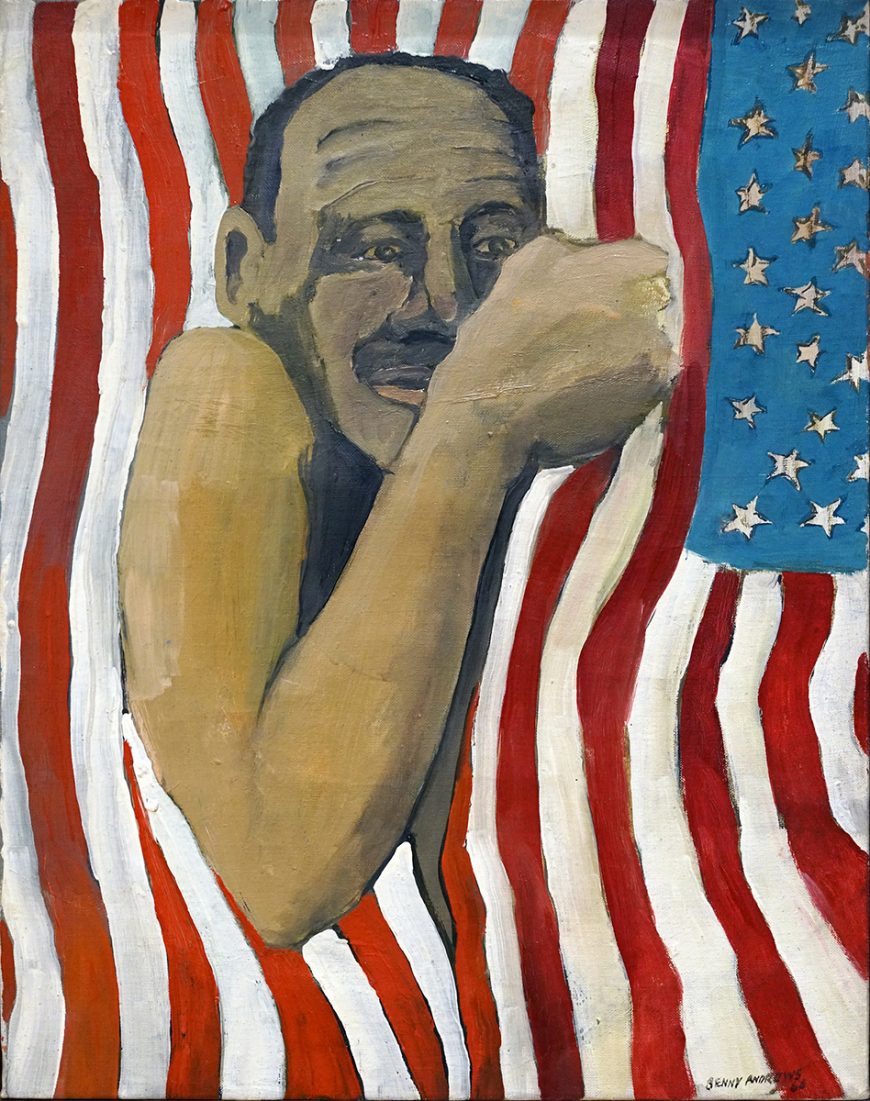
Benny Andrews, Flag Day, 1966, oil on canvas, 53.3 x 40.6 cm ©The Benny Andrews Estate (The Art Institute of Chicago) (photo: Dr. Steven Zucker)
Contemporary Art, an introduction
Conceptual Art, an introduction
Performance Art: An Introduction
Examples
Challenging viewers
Frank Stella, The Marriage of Reason and Squalor
Minimalism and Earthworks
Conceptual
John Baldessari, I Will Not Make Any More Boring Art
The Case for Yoko Ono (from The Art Assignment)
Performance and Participation
Running in sneakers, the Judson Dance Theater
Activism
Feminist
Judy Chicago, The Dinner Party
Mary Kelly, Post-Partum Document
|
Cultural heritage in focus
|
| Terms to know and use
Pop Art, Minimalism, earthworks, conceptual art, performance art, kinetic theater, feminist art, colonialism, post-colonialism, kinetic art, Chicano art movement |
25. Global trends in contemporary art
Consider contemporary art through a global lens, looking to themes to group artists.
Reframing Art History chapter
Responding to the early modern European tradition
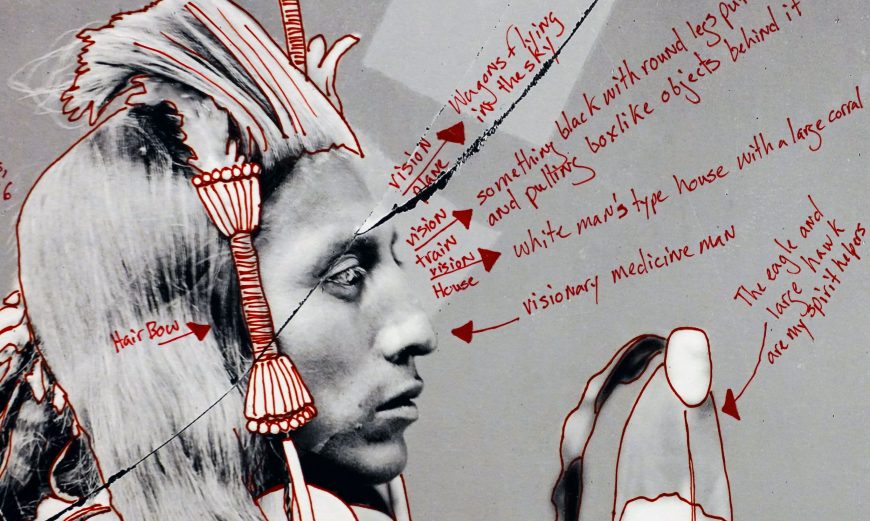
Wendy Red Star, 1880 Crow Peace Delegation, 2014, inkjet print and red ink on paper, 16 15/16 x 11 15/16 inches ©Wendy Red Star (Portland Art Museum)
Examples
Ritual spirituality, and transcendence
Emily Kame Kngwarreye, Earth’s Creation
Marina Abramović, The Artist is Present
Appropriation and ideological critique
Kara Walker, Darkytown Rebellion
Identity and the body
Carrie Mae Weems, Untitled (Woman Feed Bird), from The Kitchen Table Series
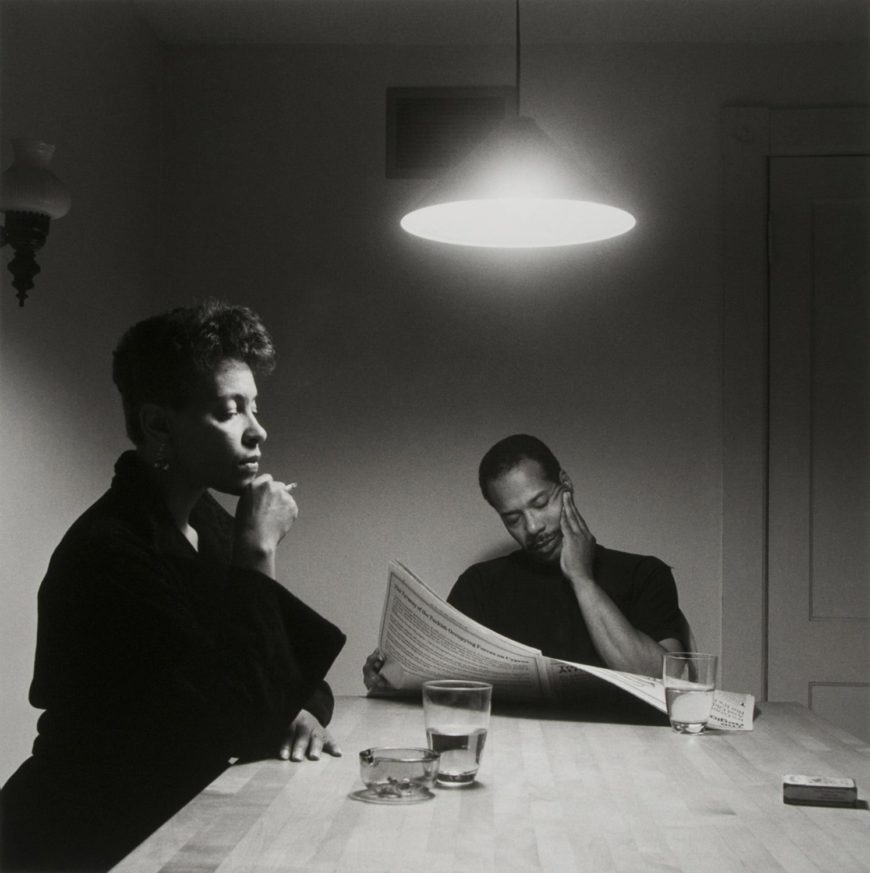
Carrie Mae Weems, Untitled, From the Kitchen Table Series, 1990 (negative), 2011 (print), Gelatin silver print, 69.2 x 69.2 cm (Philadelphia Museum of Art, © Carrie Mae Weems)
Felix Gonzalez-Torres, “Untitled” (billboard of an empty bed)
Faith Ringgold, Dancing in the Louvre
Beyte Saar, Liberation of Aunt Jemima
Yinka Shonibare, The Swing (After Fragonard)
Shirin Neshat, Rebellious Silence, Women of Allah series
Histories, real and imagined
Nam June Paik, Electronic Superhighway: Continental U.S., Alaska, Hawaii
Jaune Quick-to-See Smith, Trade (Gifts for Trading Land with White People)
Titus Kaphar, The Cost of Removal
Wendy Red Star, 1880 Crow Peace Delegation
Kehinde Wiley, Napoleon Leading the Army over the Alps
|
Cultural heritage in focus
|
Destruction as Preservation: Ai Weiwei’s Dropping a Han Dynasty Urn |
| Terms to know and use
video art, transcendence and spirituality, kinetic art, story quilt, Fluxus, the gaze, participatory artwork, postmodernism |
26–28. Placeholders for another exam, project development, and holidays
These three sessions are devoted to developing projects or exams.

